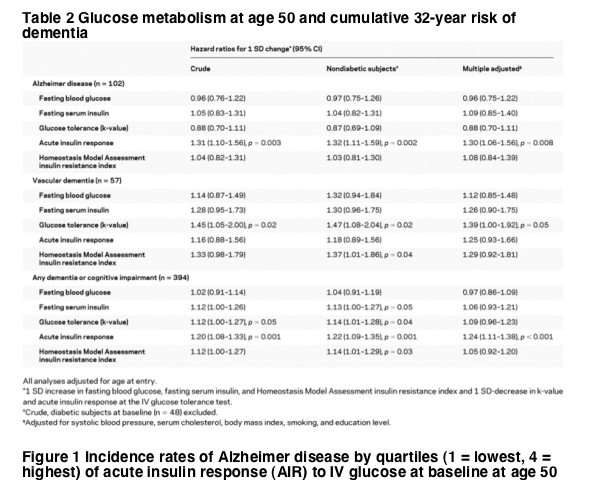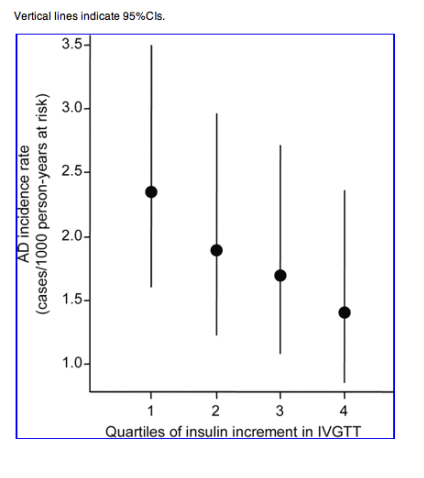| |
Impaired insulin secretion increases the risk of Alzheimer disease
|
| |
| |
NEUROLOGY 2008;71:1065-1071
Published online before print April 9, 2008, doi:10.1212/01.wnl.0000310646.32212.3a)
E. Ronnemaa, MD, B. Zethelius, MD, PhD, J. Sundelof, MD, J. Sundstrom, MD, PhD, M. Degerman-Gunnarsson, MD, C. Berne, MD, PhD, L. Lannfelt, MD, PhD and L. Kilander, MD, PhD
From the Departments of Public Health and Caring Sciences/Geriatrics (E.R., B.Z., J. Sundelof, M.D.-G., L.L., L.K.) and Medical Sciences (J. Sundstrom, C.B.), Uppsala University Hospital, Uppsala, Sweden.
"In men, impaired insulin secretion at age 50 increases the risk of developing Alzheimer's disease later in life, a longitudinal study revealed. Mid-life diabetes was associated with a 30% greater risk of developing Alzheimer's up to 35 years later (HR 1.30, 95% CI 1.06 to 1.56, P=0.008).....impaired acute insulin response to IV glucose increased risk of AD during 32 years of follow up. Similar results were obtained also after adjustment for other potential risk factors for AD as well as fasting insulin and HOMA-I.....nduction of insulin resistance has been shown to result in decreased insulin transport into the brain.19 The ultimate consequence of the insulin-resistant state is impaired metabolic function and growth signals in insulin-sensitive tissues, including the brain, which has a rich supply of insulin receptors. Together these data emphasize the importance of insulin, both acute and long-term exposure, in normal brain function. Insulin could affect the risk of AD by direct action on the neurons or modulation of energy metabolism in the hippocampus and the cortex.20 Another possible mechanism underlying the cerebral accumulation of β-amyloid (Aβ) could involve the regulation of tau hyperphosphorylation through defective insulin signaling.21 Furthermore, insulin is shown to stimulate Aβ secretion and inhibit the extracellular degradation of Aβ by competition for insulin-degrading enzyme (IDE).22"
Abstract.
Objective: Subjects with diabetes are reported to have an increased risk of dementia and cognitive impairment. However, the underlying causes remain unknown. We investigated the longitudinal associations between midlife insulin secretion, glucose metabolism, and the subsequent development of Alzheimer disease (AD) and dementia.
Methods: The population-based Uppsala Longitudinal Study of Adult Men started 1970 when the 2,322 participants were 50 years old. Investigation at baseline included determinations of acute insulin response and glucose tolerance using the IV glucose tolerance test and Homeostasis Model Assessment insulin resistance index. During a median follow up of 32 years, 102 participants were diagnosed with AD, 57 with vascular dementia, and 394 with any dementia or cognitive impairment. Associations were analyzed using Cox proportional hazard models.
Results: A low insulin response at baseline was associated with a higher cumulative risk of AD (hazard ratio for 1 SD decrease, 1.31; 95% CI, 1.10-1.56) also after adjustment for age, systolic blood pressure, body mass index, serum cholesterol, smoking, education level, and insulin resistance. This association was stronger in subjects without the APOE {varepsilon}4 allele. Impaired glucose tolerance increased the risk of vascular dementia (hazard ratio for 1 SD decrease, 1.45; 95% CI, 1.05-2.00) but not AD. Impaired insulin secretion, glucose intolerance, and estimates of insulin resistance were all associated with higher risk of any dementia and cognitive impairment.
Conclusions: In this longitudinal study, impaired acute insulin response at midlife was associated with an increased risk of Alzheimer disease (AD) up to 35 years later suggesting a causal link between insulin metabolism and the pathogenesis of AD.
Abbreviations: AD = Alzheimer disease; AIR = acute insulin response; HOMA = Homeostasis Model Assessment.
Diabetes and dementia are common disorders that affect a large proportion of populations worldwide and both are increasing in prevalence.1 Interventions that could prevent or postpone the onset of dementia would have a major effect on public health.2 Diabetes is reported to increase the risk of cognitive impairment and dementia as reviewed previously.3 However, the underlying causes behind these associations remain unclear as well as whether the risk linked to diabetes is specific for Alzheimer disease (AD), vascular dementia, or nonspecific for cognitive deterioration in general.
Neurodegeneration leading to dementia starts decades before clinical symptoms emerge. Previous longitudinal studies have measured glucose tolerance at midlife and risk of dementia with conflicting results.4,5 Impaired glucose tolerance and type 2 diabetes are characterized by altered insulin secretion and insulin resistance. A previous study found that hyperinsulinemia at midlife was associated with greater cognitive decline over a 6-year period.6 The relationship of insulin secretion and insulin resistance at midlife with AD has not been assessed previously.
We tested the hypothesis that disturbances in glucose and insulin metabolism measured with the IV glucose tolerance test at 50 years of age would lead to an increased risk of AD and dementia later in life. The longitudinal analyses with up to 35 years of follow up were conducted in a population-based cohort of 2,322 men in Uppsala, Sweden.
DISCUSSION
In this longitudinal analysis comprising of 58,692 person-years, we found an association between an impaired acute insulin response to IV glucose and increased risk of AD during 32 years of follow up. Similar results were obtained also after adjustment for other potential risk factors for AD as well as fasting insulin and HOMA-IR.
Several studies have examined the association between fasting insulin and AD with partly conflicting results or found a U-shaped relationship between plasma insulin concentrations and AD.16 This indicates that both insulin deficiency and compensatory hyperinsulinemia may increase the risk of AD. The relationship between insulin resistance and beta-cell failure during the course of development of type 2 diabetes mellitus is complex. Consequently, we attempted to separate impaired acute insulin secretion and hyperinsulinemia resulting from insulin resistance in multiple regression models.
The most consistent finding, an association between AIR and AD, was stronger in subjects without the APOE {varepsilon}4 allele indicating that impaired AIR is an important risk factor for AD when the high risk allele is missing. This observation finds some support in an experimental study in which IV insulin administration facilitated cognitive functions only in patients without the APOE {varepsilon}4 allele.17 HOMA-IR and high fasting insulin concentrations, which are closely correlated, increased the risk of AD only in the subjects with the APOE {varepsilon}4 allele in our study. This finding is in similar to another longitudinal study6 but contrary to a previous cross-sectional report.18
Induction of insulin resistance has been shown to result in decreased insulin transport into the brain.19 The ultimate consequence of the insulin-resistant state is impaired metabolic function and growth signals in insulin-sensitive tissues, including the brain, which has a rich supply of insulin receptors.
Together these data emphasize the importance of insulin, both acute and long-term exposure, in normal brain function. Insulin could affect the risk of AD by direct action on the neurons or modulation of energy metabolism in the hippocampus and the cortex.20 Another possible mechanism underlying the cerebral accumulation of β-amyloid (Aβ) could involve the regulation of tau hyperphosphorylation through defective insulin signaling.21 Furthermore, insulin is shown to stimulate Aβ secretion and inhibit the extracellular degradation of Aβ by competition for insulin-degrading enzyme (IDE).22
A genetically determined propensity to pancreatic beta cell dysfunction results in impaired insulin secretion, whereas insulin resistance is almost invariably associated with the cluster of cardiovascular risk factors constituting the metabolic syndrome.23 The observed association between AD and impaired AIR could represent another evidence of a linkage in genetic studies. Recent genomewide scans for gene variants linked to type 2 diabetes have found an association signal to the CDKA1 gene similar to the CDK5 regulatory subunit-associated protein gene.24 CDK5 overactivation is a component of the AD pathophysiology.25,26 The same gene is also overexpressed in pancreatic beta-cells subject to glucotoxicity, which ultimately lead to impaired insulin secretion.27
In contrast to AD, there was a significant association among glucose intolerance, insulin resistance, and vascular dementia. Insulin resistance is associated with atherosclerosis28 and diabetes is a well-known risk factor for lacunar infarction29 and stroke.30 Hyperglycemia is accompanied by accumulation of advanced glycation end products, oxidative stress, and microvascular changes, which might lead to cerebral ischemia. The metabolic syndrome or insulin resistance syndrome has previously been shown to be associated with cognitive decline31 and cognitive impairment with subcortical features.32 It is possible that insulin resistance or impaired glucose tolerance leads to a clinical state in which cerebrovascular disease substantially influences the dementia in which AD mechanisms may be less important. In patients with impaired insulin secretion, amyloid-related mechanisms may predominate and lead to a dementia that we clinically classify as AD without cerebrovascular disease.
The strengths of this study include the large population-based cohort, long follow-up period, detailed baseline metabolic characterization of the population at midlife, and detailed classification of dementia. After eliminating diabetic subjects, we found that the associations among impaired insulin secretion, glucose intolerance, insulin resistance, and dementia were stronger than in the whole cohort, thus eliminating the possibility that the diabetic state or its treatment at baseline influenced our results. The results did not change after repeated analyses with nonsurvivors were excluded, minimizing the possibility of competing risks or chance findings resulting from inclusion of subjects who might have died with undiagnosed AD or other dementias. As a result of the common coexistence of impaired glucose metabolism, hypertension, hyperlipidemia, and obesity, their inclusion in one multiple adjusted model can result in overadjustment and contribute to the lack of significant associations between variables of glucose metabolism and dementia. In contrast, even after adjustment for vascular risk factors, the association between AIR and AD remained significant, indicating that impaired insulin secretion is an independent risk factor for AD.
We undertook multiple measures to improve the diagnostic precision of dementia. A detailed clinical assessment and medical history was carried out on all subjects with a specific dementia subtype classification and neuroimaging was available for the majority of the cases. The diagnostic workup was made at the geriatric memory clinic in the majority of the cases and additional information was retrieved from all available medical records obtainable from hospitals and outpatient clinics. The cases of possible and mixed dementia were not included in AD or vascular dementia groups for higher specificity. Because the primary interest was to study disease-specific mechanisms, strict criteria for AD were important. Like in any epidemiologic study, there is a risk that some cases did not attend medical care. However, in the present study, these cases are probably very few and most importantly, any false-negative cases would drive the results toward the null hypothesis.
The subjects with APOE {varepsilon}4 genotyping were all participants of a follow-up study 20 years after baseline. Despite the selection survival bias, this subsample is representative because most of the dementia cases were diagnosed after 70 years of age.
Finally, the study was restricted to men of the same age in an ethnically homogeneous geographic region, reducing confounding by other genetic, disease, age, and sex-related factors. However, these same factors can also put forward as limitations of the generalizability.
RESULTS
Table 1 shows the clinical characteristics at baseline at age 50. A total of 394 persons developed dementia or cognitive impairment of which 102 were pure AD and 57 pure vascular dementias. The incidence rate during a median 32 years follow-up period for AD was 1.7 per 1,000, for vascular dementia 0.9 per 1,000 and for any dementia and cognitive impairment 6.6 per 1,000 person-years at risk.
In crude Cox proportional hazard analyses, low AIR was associated with a higher risk of AD and the association remained significant even after adjustment for systolic blood pressure, serum cholesterol, body mass index, and education level (table 2). The highest risk was observed in the lowest quartile of AIR (figure 1).


|
|
| |
| |
|
|
|